When it comes to farming, having the right tools and equipment is essential for success. Whether you’re just starting out or have been in the farming business for years, having the proper tools can make all the difference. In this article, we’ve compiled a list of the top 25 best farm tools and equipment, as well as how to use them on your farm.
What are Farm Tools and How are they Helpful?
Farming tools are an important part of agriculture and can help farmers in their daily tasks. As the range of farming tasks has grown, so has the variety of tools available to farmers. Understanding the various categories of farming tools is essential for any farmer who wants to be successful in their craft.
Classification of Farming Tools and Their Examples
As the agricultural industry continues to evolve, so does the range of tools and machines used to make it possible. Depending on their use, these items can generally be classified into four different types of agricultural tools and machines: harvesting, tilling, planting, and processing.
Read More: 10 Most Profitable Livestock Farming Business Ideas – Green lifo
Harvesting tools and machines:
Harvesting tools and machines are used to collect crops or produce that has been grown in the field. This includes equipment like combine harvesters, pickers, threshers, diggers, silage cutters and more. With harvesting tools and machines such as these, farmers can quickly and efficiently gather a harvest of fruits, vegetables, grains or any other kind of crop they may have grown.
Tilling tools and machines:
Tilling tools and machines are essential for cultivating land before planting takes place. They are also used after harvesting has finished to prepare the ground for next season’s crops. These tools may include plows, cultivators and various kinds of tractors that help loosen the soil for easy planting.
Planting tools and machines:
Play a crucial role in preparing land for sowing seeds or transplants. Equipment such as planters, seed drills and air-seeders help ensure that seedlings have optimal growing conditions from the start. As well as this, a variety of weeders or chemical sprayers may also be employed in order to get rid of any unwanted plants that may interfere with crop production.Finally,
Processing tools and machines:
Processing tools and machines are responsible for turning harvested crops into products for market consumption or storage. This could include sorting machinery that removes damaged pieces of produce; grading machinery which sorts fruit according to size; drying machinery which reduces water content; packaging machinery which wraps individual pieces or groups into suitable packages; plus a whole host of other machinery too.
Overall then, there is an impressive range of agricultural tools and machines available today that allow farmers to grow high quality crops while maintaining efficiency in their operations.
In case you missed it: Sorghum Farming Guide: A Complete Guide to Growing Sorghum 2023
25 Common farm tools and equipment: Names, pictures, and uses
Here are some of the common farm tools names with their uses and images:
1.Shovel
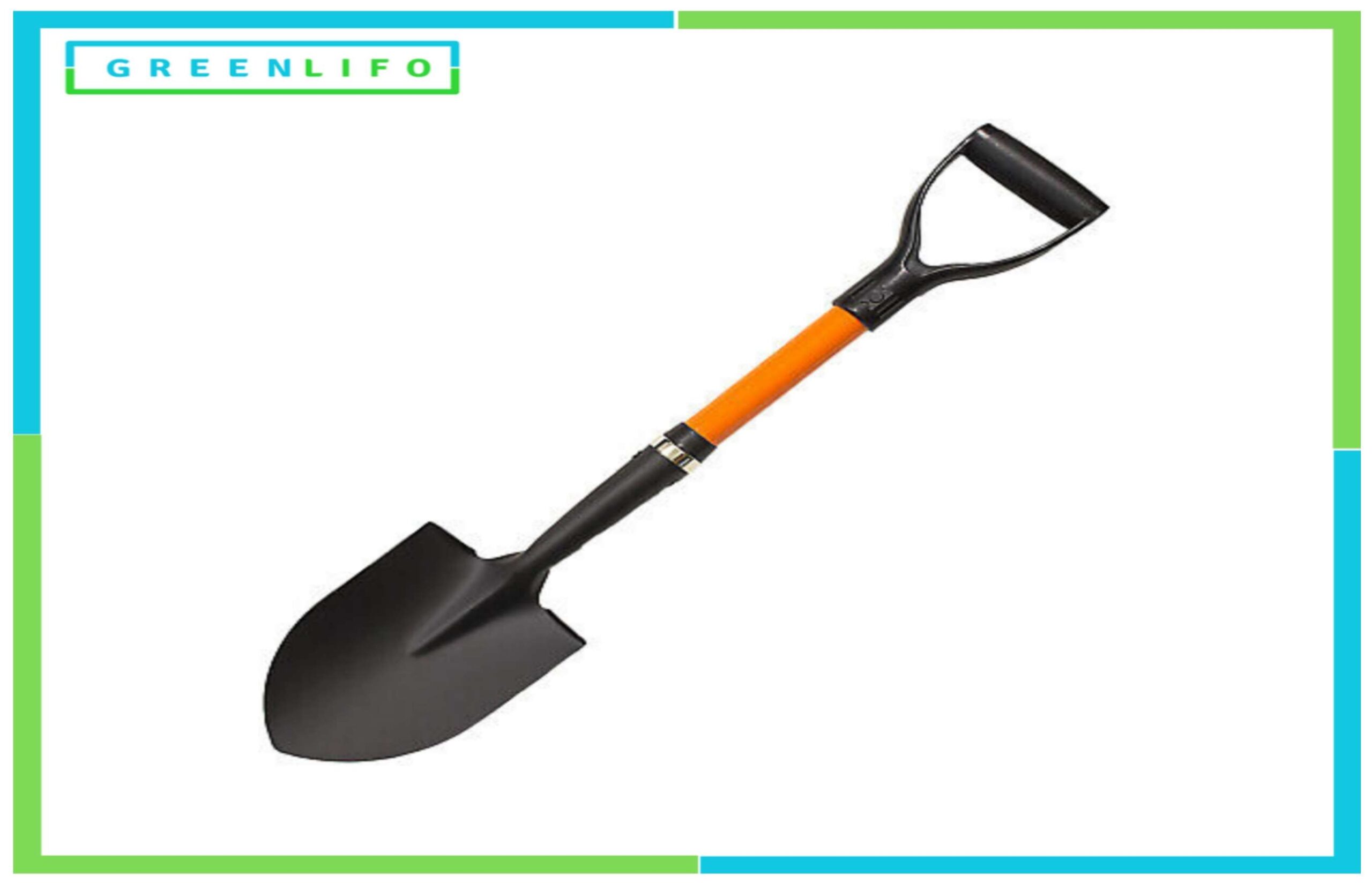
Shovels are essential farm tools used to accomplish a variety of tasks, from digging soil and removing rocks to cleaning out grain silos. The shovel is one of the oldest farming implements still in use today, and its importance continues to remain strong even with the advances of modern machinery.
Here are the uses of a shovel:
1. Digging: Shovels are mainly used for digging. It can be used to dig holes to plant trees, bushes or crops.
2. Lifting and Moving Soil: Shovels are excellent for lifting and moving soil, sand, or gravel from one place to another. This is useful for tasks like filling garden beds or leveling ground.
3. Clearing Debris: Shovels can be used to clear debris or snow from driveways, sidewalks, and other surfaces.
4. Creating Trenches: Shovels are used to create trenches for various purposes, including laying irrigation lines or burying cables.
5. Mixing Materials: Shovels are also used to mix materials such as concrete or mortar when working on construction projects.
6. Cleaning Livestock Areas: In farms, shovels are used to clean livestock areas, such as stables and barns, by removing manure and soiled bedding.
7. Landscaping: Shovels are essential for landscaping tasks like reshaping garden beds, creating berms, or installing retaining walls.
8. Building and Construction: Shovels are commonly used in construction to move earth and materials during building projects.
9. Emergency Purposes: Shovels can be used for emergency purposes, such as digging out a stuck vehicle in snow or mud.
10. Creating Drainage: Shovels are employed to dig ditches or channels for drainage, helping to manage water flow in gardens or fields.
2. Spade

A spade is an agricultural tool with a sharp blade used for digging, shoveling and loosening soil. It’s very similar to the shovel. It’s an essential part of any farmer’s equipment arsenal, allowing them to more easily and efficiently tend to their crops.
Here are the uses of a spade:
1. Digging Holes: Spade are primarily used for digging holes in the ground. This is especially important for planting trees, shrubs, or flowers.
2. Turning Soil: Spade are excellent for turning and aerating soil. This process helps improve soil structure and prepares it for planting.
3. Creating Edges: Spade are used for creating neat edges around flower beds, pathways, or lawns, giving the garden a polished appearance.
4. Removing Weeds: Spade can be employed to dig out and remove weeds from the garden or lawn.
5. Transplanting: Spade are useful for transplanting plants from one location to another. They allow you to lift a plant with its root ball intact.
6. Mixing Soil: Spade can be used to mix different types of soil, compost, or other soil amendments to create a suitable planting mixture.
7. Creating Trenches: Spade are used to dig narrow and shallow trenches for tasks like burying irrigation lines or edging walkways.
8. Excavation in Tight Spaces: Spade are effective in tight spaces where larger tools like shovels may not fit. They are ideal for detailed excavation work.
3. Rake
The rake is essentially a hoe with a handle and multiple curved teeth which can be used for various purposes in agriculture. It is typically made of metal and has long tines, or teeth, attached to its head. Rakes are typically used to move hay or other crop residues such as corn stalks and small stones, level soil before planting, spread fertilizer or remove weeds.
Here are the uses of a rake:
1. Leaf and Debris Collection: Rakes are commonly used to gather fallen leaves, grass clippings, and other debris from lawns, gardens, and pathways.
2. Soil Leveling: Rakes with flat tines can be used to level and smooth the soil’s surface in preparation for planting or seeding.
3. Preparing Garden Beds: Rakes are useful for preparing garden beds by breaking up soil clumps and creating a fine, even surface.
4. Removing Thatch: Thatch is a layer of dead grass and organic matter that can accumulate on lawns. Rakes are used to dethatch and remove this layer, allowing grass to grow more healthily.
5. Spreading Mulch: Rakes can evenly spread mulch or compost over garden beds to retain moisture and control weeds.
6. Clearing Snow: In regions with snowy winters, snow rakes are used to clear snow from roofs to prevent damage and ice dams.
7. Harvesting Grains: Specialized rakes, such as grain rakes, are used for harvesting grains and other crops by gently pulling them to the ground.
8. Creating Furrows: Rakes can be used to create furrows or rows in the soil for planting seeds or seedlings.
Rakes come in various shapes and sizes, making them versatile tools for a wide range of outdoor tasks, from lawn maintenance to agriculture and landscaping.
4. Bolo
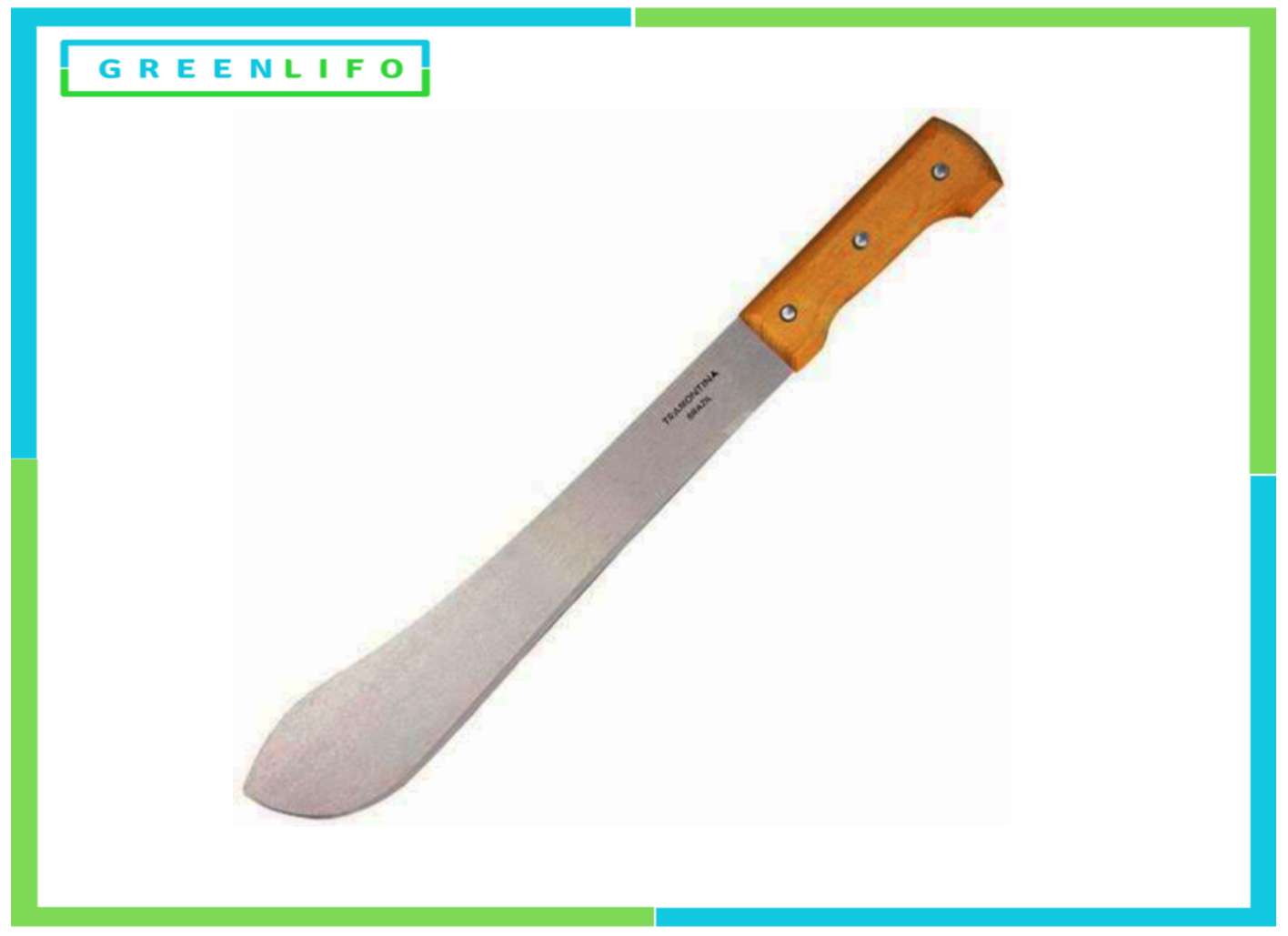
If you’re looking for a versatile cutting tool, the Bolo is definitely the way to go! A Bolo knife is typically a knife-like instrument that’s used for various types of cutting. From clearing out vegetation and tall weeds to chopping branches off trees, the Bolo has a wide range of uses.
Here are the uses of a bolo:
1. Cutting Grass: Bolos are commonly used to cut tall grass, weeds, and undergrowth in fields and gardens.
2. Harvesting Crops: Bolos can be used to harvest certain crops like rice, corn, and sugarcane by cutting the stalks close to the ground.
3. Clearing Brush: Bolos are effective for clearing brush and dense vegetation, making it easier to access an area.
4. Trail Maintenance: Bolos are used for maintaining hiking trails and paths by cutting overgrown vegetation that may obstruct the way.
5. Pruning Small Trees: Bolos can be used to prune and trim small trees and branches.
6. Weeding: Bolos are suitable for weeding, especially in areas where the use of herbicides is not desired.
7. Camping and Survival: Bolos are sometimes carried as survival tools for cutting wood, clearing campsites, or self-defense.
8. Construction and Carpentry: Bolos can be used in construction and carpentry for tasks like shaping wood and trimming branches.
9. Cutting Firewood: Bolos are useful for cutting smaller logs and branches into firewood.
5. Sickle
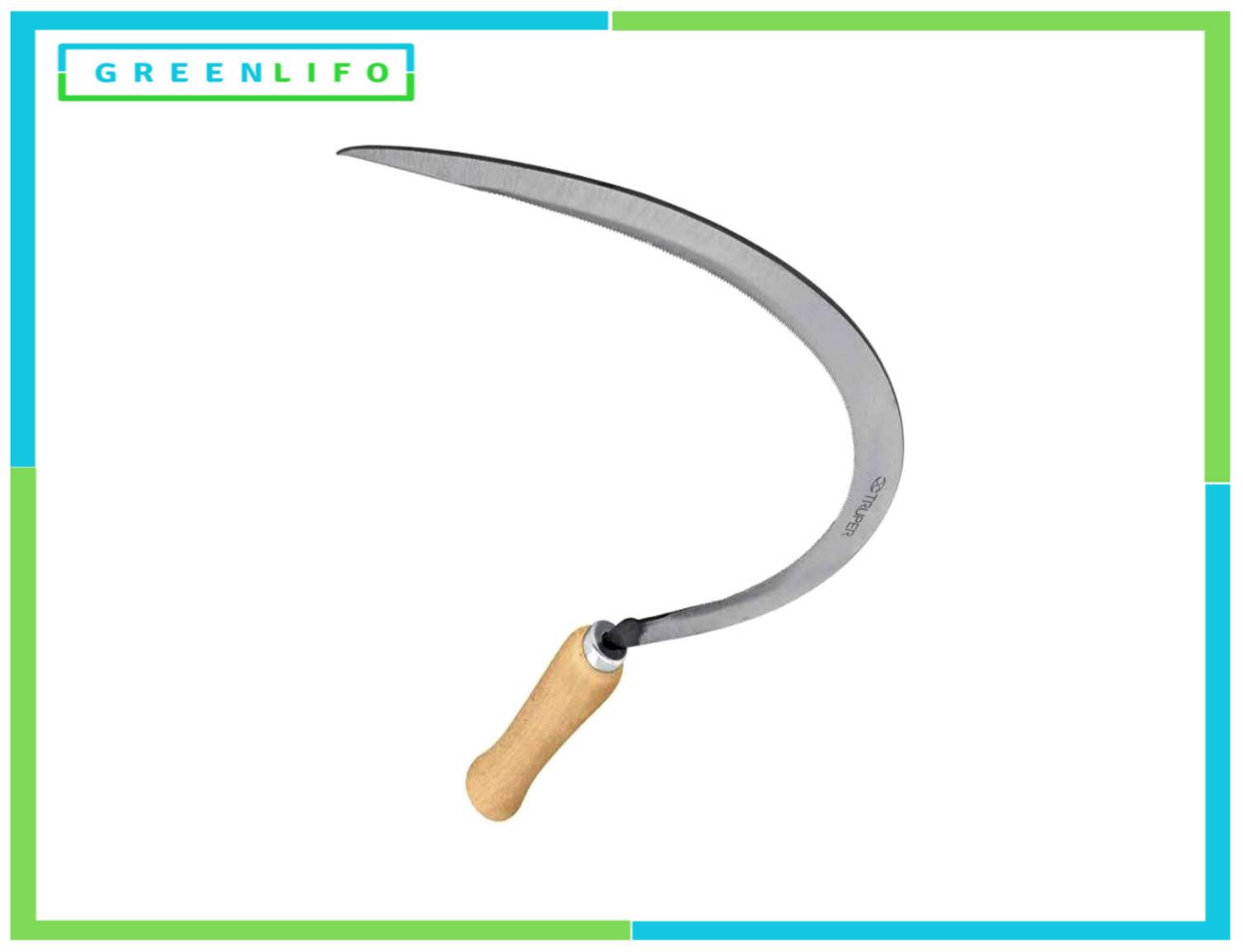
A sickle is an ancient farming tool used for harvesting crops, typically consisting of a metal blade with a handle attached to it. Today, modern farmers still use sickles for harvesting and other agricultural tasks. The curved shape of the blade makes it easier to cut through stalks of grain and tall grasses while its pointed edge helps separate plants from soil.
Here are the uses of a sickle:
1. Harvesting Crops: Sickles are primarily used for harvesting crops such as grains, wheat, barley, and rice. The sickle’s curved blade is ideal for cutting through the stalks close to the ground.
2. Cutting Grass: Sickles are commonly used for cutting tall grass and weeds, making them useful in both agriculture and landscaping.
3. Pruning Fruit Trees: Sickles can be used for pruning fruit trees and bushes by cleanly cutting branches and twigs.
4. Weeding: In traditional and organic farming, sickles are employed for weeding tasks, particularly in areas with row crops.
5. Clearing Undergrowth: Sickles are effective for clearing undergrowth in forests, parks, and natural areas, allowing for better access.
6. Creating Bundles: Sickles can be used to cut and tie together bundles of crop stalks or other materials.
7. Traditional Crop Harvest Festivals: In some cultures, sickles are used in traditional harvest festivals, symbolizing the gathering of crops.
8. Wildflower Harvesting: Sickles are used by florists and hobbyists to harvest wildflowers and grasses for decorative arrangements.
9. Craftsmanship: Craftsmen and artisans use sickles for intricate carving and shaping tasks, especially in traditional craftsmanship.
10. Shearing Animal Fodder: Sickles are sometimes used to cut and harvest fodder for livestock and animals.
6. Sprayer
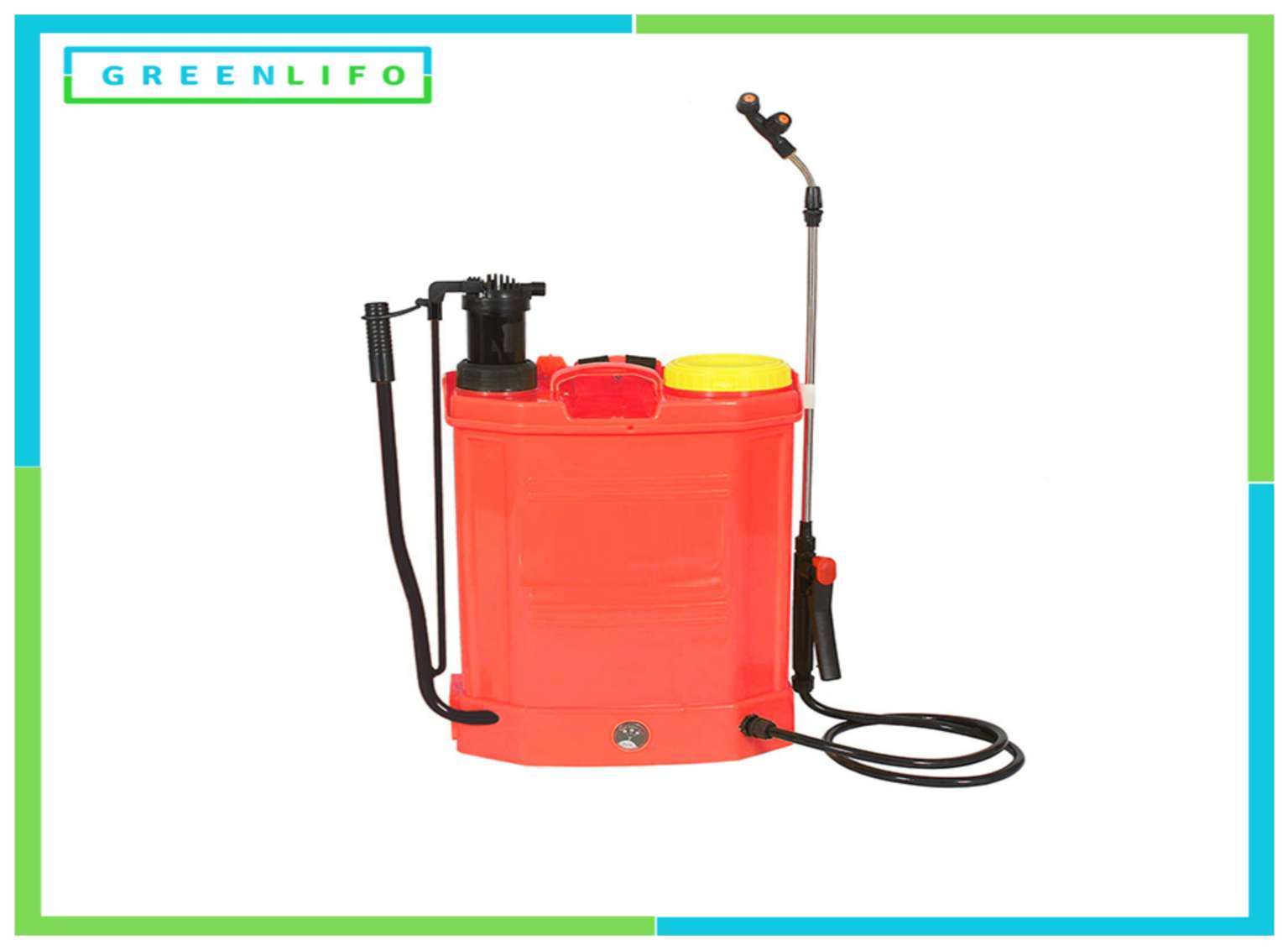
A sprayer is a device that helps farmers to apply pesticides, fertilizers, and other liquids to their fields. With the help of these tools, you can save time and effort when it comes to controlling pests and helping your plants grow healthy and strong.
Here are the uses of a sprayer:
1. Pesticide Application: Sprayers are commonly used in agriculture to apply pesticides, insecticides, and herbicides to crops, protecting them from pests and diseases.
2. Fertilizer Application: Sprayers are essential for distributing fertilizers evenly across fields, ensuring proper nutrient absorption by plants.
3. Weed Control: Herbicide sprayers are used to target and control weeds in fields, gardens, and lawns without harming desired plants.
4. Crop Protection: Sprayers can apply fungicides and other protective agents to prevent or treat plant diseases.
5. Insect Control: Insecticide sprayers are used to control insect infestations in crops and orchards, reducing damage and improving yields.
6. Irrigation: Some sprayers are used for irrigating plants with a fine mist, especially in greenhouses or for delicate plants.
7. Cleaning and Sanitizing: Sprayers can be used to clean and sanitize equipment, surfaces, and agricultural buildings.
8. Applying Growth Regulators: Sprayers are used to apply growth regulators that help control the height and growth of certain crops.
9. Dusting: Some sprayers are designed for dusting crops with pesticides or powders to control pests.
7. Pick mattock
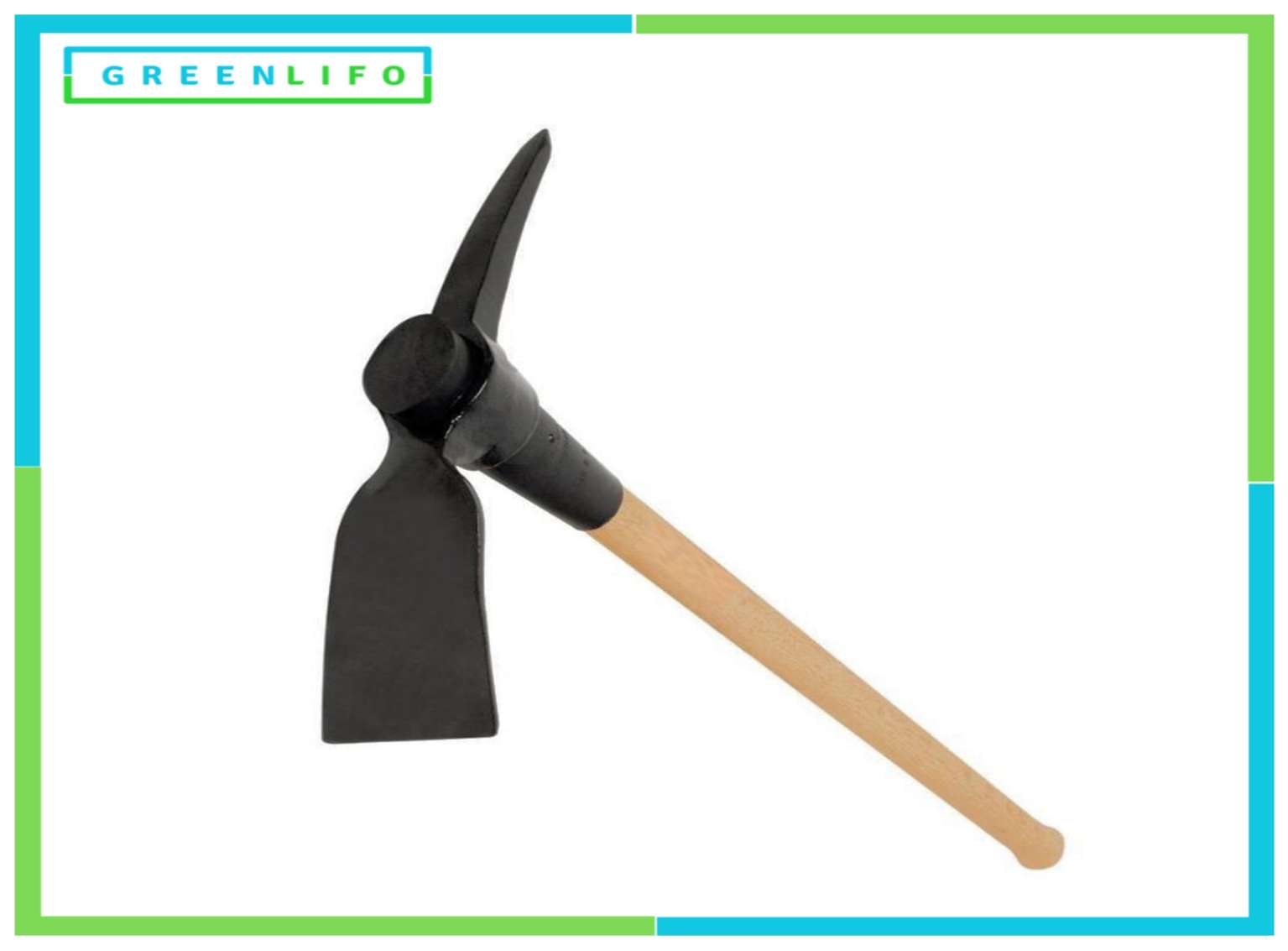
If you’re looking for a tool that will make digging in your garden or yard easier, a mattock is the perfect choice. This versatile tool is designed to do it all, from breaking up soil to cutting through roots. Whether you’re planting a garden or clearing an area for a new flowerbed, a mattock will get the job done faster and with less effort.
Here are the uses of a pick mattock:
1. Digging: The pick mattock’s pick end is designed for breaking and loosening hard or compacted soil, making it useful for digging holes, trenches, or for planting trees and shrubs.
2. Cutting Roots: The pick end can be used to cut and sever roots when digging or removing shrubs and small trees.
3. Breaking Rocks: Pick mattocks are effective for breaking up rocks and stones in the soil, especially in rocky terrain.
4. Clearing Stumps: When removing tree stumps, the pick end can be used to break up the roots and loosen the stump from the ground.
5. Trenching: Pick mattocks are suitable for creating narrow trenches, often needed for installing irrigation systems or burying cables.
6. Excavation in Compact Soil: The mattock end with its flat blade is used for digging and chopping through compacted soil.
7. Trail and Path Construction: Pick mattocks are useful for trail and path construction by clearing vegetation and creating pathways.
8. Landscaping: Landscapers use pick mattocks to shape terrain, level surfaces, and create contours in gardens and yards.
8.Grab Hoe
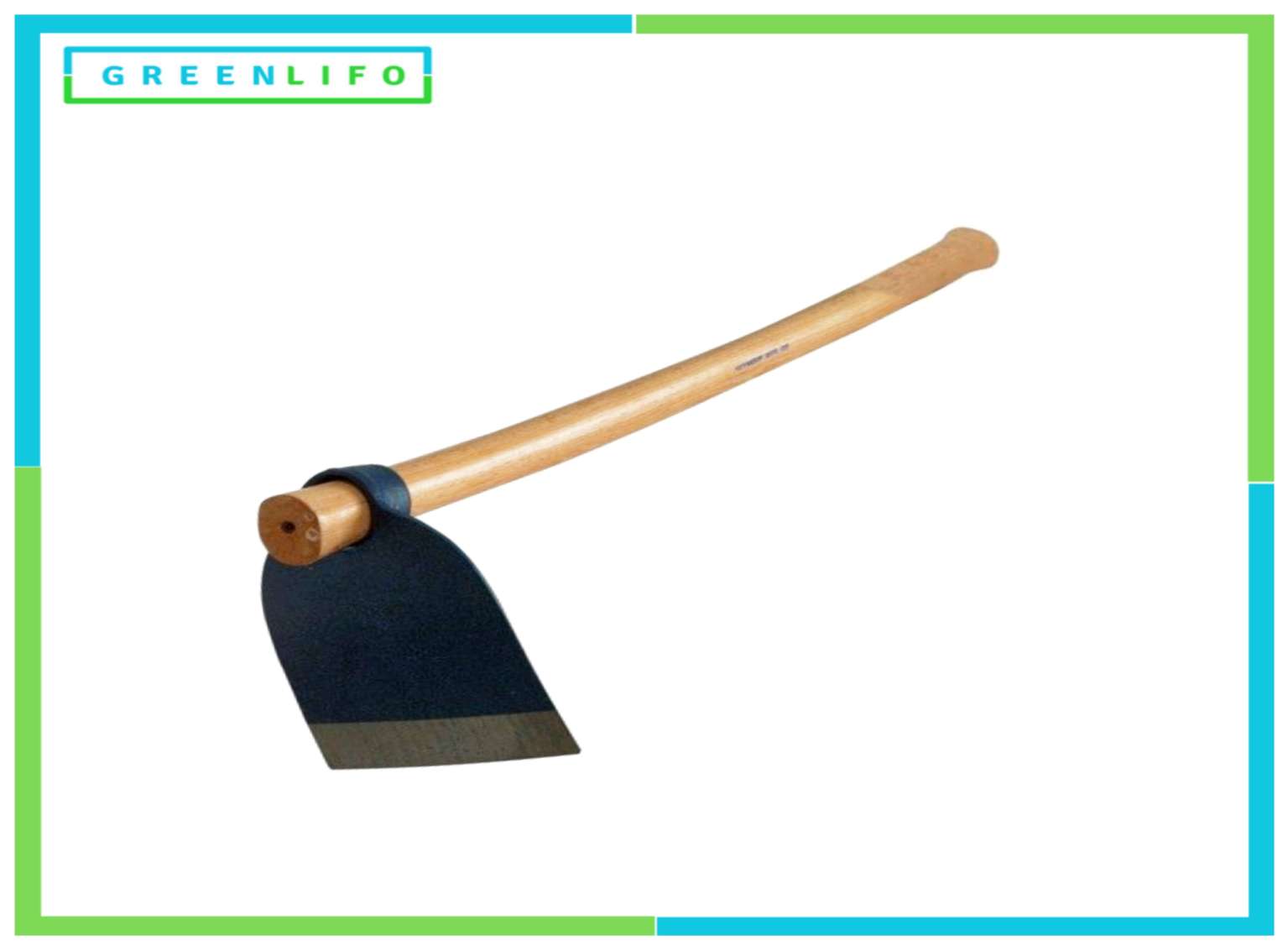
A hoe is an agricultural tool that is used for digging, uprooting weeds, and chopping through roots and soil. Hoes are great for cultivating soil, removing weeds from your garden, and for other tasks like digging holes for planting trees and shrubs.
Here are the uses of a grab hoe:
1. Weeding: Grab hoes are excellent for weeding tasks in gardens, farms, and fields. The curved blade easily cuts through and uproots weeds.
2. Cultivation: They can be used for cultivating soil, breaking up clumps, and preparing the ground for planting.
3. Digging: Grab hoes are suitable for digging holes, trenches, and furrows, especially in tight or confined spaces.
4. Planting: They can help create planting rows or holes for seeds, seedlings, and bulbs.
5. Transplanting: Gardeners use grab hoes to carefully lift and relocate plants while minimizing root disturbance.
6. Clearing Roots: The blade of a grab hoe is effective at cutting through and removing small roots, making it useful for clearing areas.
7. Edging Beds: Grab hoes can create clean edges around garden beds, pathways, and lawns for a neat appearance.
8. Loosening Soil: They are used to loosen compacted soil, improving aeration and water penetration.
9. Trenching: Grab hoes can create narrow and shallow trenches for various purposes, including laying irrigation lines or edging.
10. Hill-Up Soil: Gardeners use grab hoes to hill-up soil around plants, providing additional support and promoting root growth.
9. Crowbar

Crowbars are typically made from metal such as iron or steel, with their primary purpose being to remove nails and separate pieces of material such as wood and concrete. Crowbars are used mainly in the farm to pry apart objects that are stuck together.
Here are the uses of a crowbar:
1. Prying: Crowbars are primarily used for prying apart or separating objects. They can be wedged into tight spaces to exert force and open or lift things.
2. Demolition: Crowbars are valuable tools in demolition work, allowing users to dismantle structures by prying apart materials like wood, nails, or drywall.
3. Removing Nails: Crowbars are effective for removing nails or staples from wood, walls, or other surfaces. The flat end is used to grip the nail, and the curved end is used to lever it out.
4. Leverage: They provide leverage to move heavy objects or lift items, such as lifting floorboards, moving heavy rocks, or appliances.
5. Breaking and Splitting: Crowbars can be used for breaking apart concrete, stones, and other hard materials by applying force with the prying end.
6. Carpentry and Framing: In construction, crowbars are used to align and adjust framing elements, such as wall studs and beams.
10. Wheelbarrow
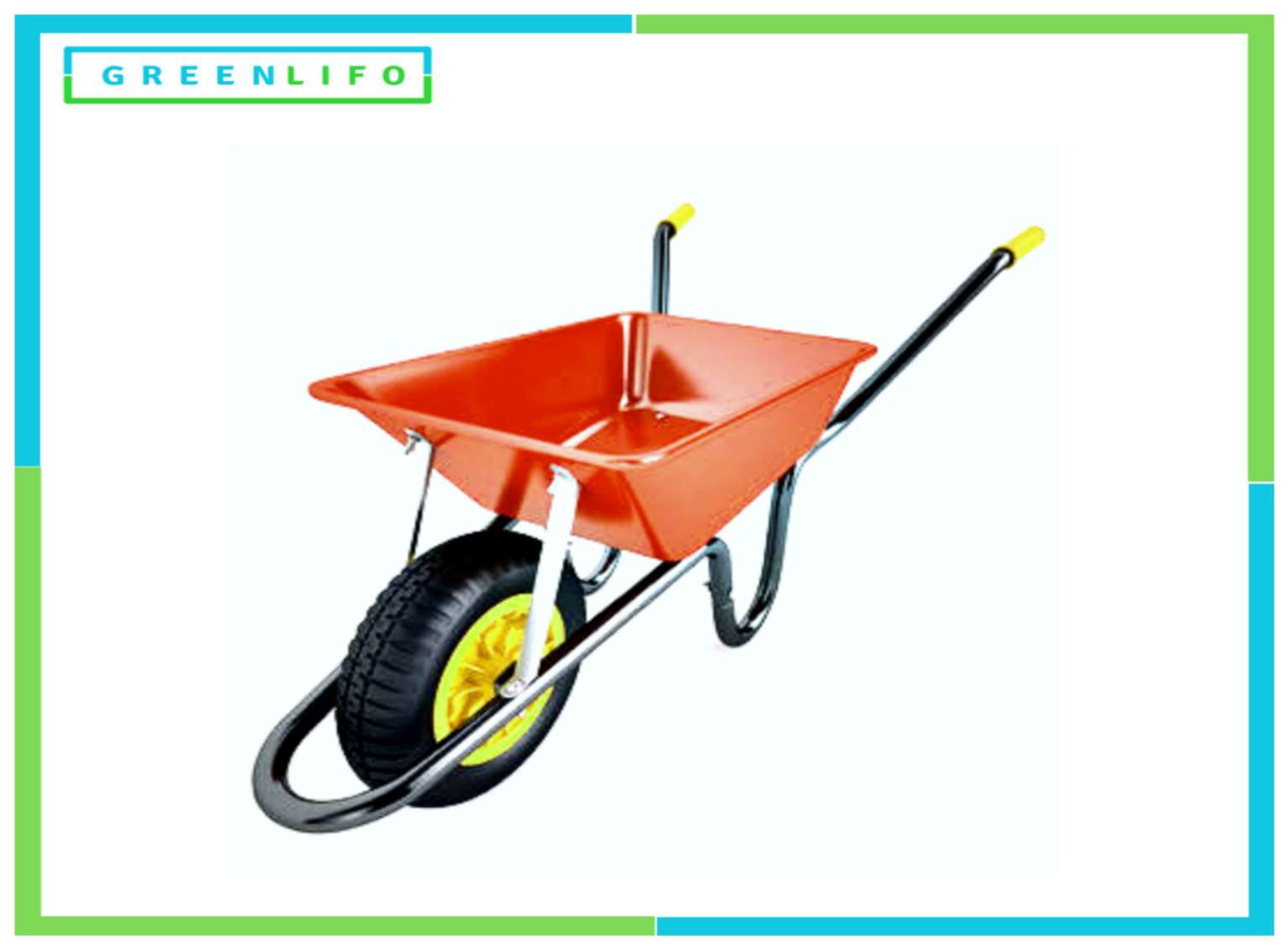
A wheelbarrow is a farming tool commonly used for transporting materials such as soil, rocks, plants, and mulch. This handy gardening device typically consists of two handles, one at the front and one at the back, connected to a single wheel in the middle.
Here are the uses of a wheelbarrow:
1. Transporting Heavy Loads: Wheelbarrows are designed for carrying heavy and bulky loads, such as soil, mulch, gravel, or construction materials.
2. Gardening: Gardeners use wheelbarrows to move soil, compost, and plants around the garden, making it easier to create and maintain garden beds.
3. Construction: In construction, wheelbarrows are essential for transporting concrete, sand, bricks, and other building materials to the construction site.
4. Hauling Mulch and Bark: Wheelbarrows are useful for distributing mulch or bark chips to cover garden beds and pathways.
5. Moving Firewood: They make transporting firewood from a woodpile to the fireplace or stove more convenient.
6. Lawn Care: Wheelbarrows are used for collecting and disposing of grass clippings, leaves, and other yard waste.
7. Farming: Farmers use wheelbarrows to move feed, livestock bedding, and harvested crops like fruits and vegetables.
8. Clearing Debris: Wheelbarrows help clear debris from construction sites, gardens, and yard clean-up projects.
11. Hand fork

A hand fork is a tool designed to help people in various farming and gardening tasks. It has a handle and three tines made of metal, plastic or wood which are used for digging, cultivating, aerating and weeding the soil.
Here are the uses of a hand fork:
1. Weeding: Hand forks are ideal for weeding tasks in gardens, flower beds, and vegetable patches. They can be used to loosen and remove weeds, especially in tight spaces.
2. Aerating Soil: Hand forks help aerate the soil by creating small holes or channels, allowing air and water to penetrate the root zone and promote healthy plant growth.
3. Loosening Soil: They are used for loosening compacted soil, making it easier to plant new seeds or bulbs and improve soil structure.
4. Transplanting Seedlings: Hand forks are valuable for transplanting small seedlings and delicate plants, minimizing root disturbance.
5. Harvesting Root Vegetables: Gardeners use hand forks to harvest root crops such as potatoes, carrots, and radishes by gently lifting them from the soil.
6. Dividing Perennials: Hand forks can be used to divide and separate perennial plants, making them easier to propagate and control.
7. Mixing Soil Amendments: Gardeners use hand forks to blend soil amendments, compost, or fertilizers into the soil before planting.
8. Removing Stones and Debris: Hand forks are useful for clearing small stones, debris, and roots from garden beds.
12. Pruning shears
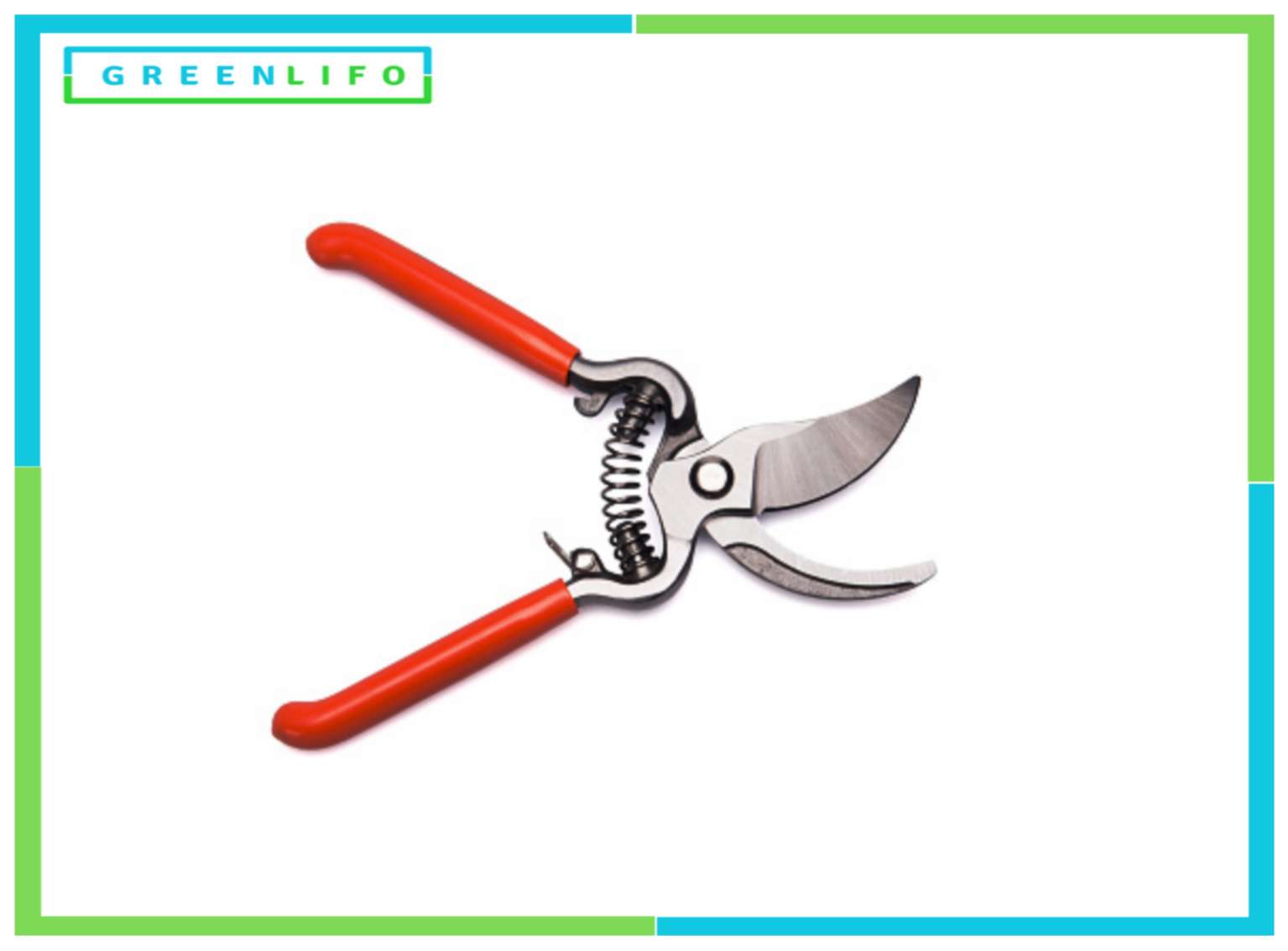
Pruning shears are essential tools for any farm or gardening operation. These powerful and sharp tools help maintain healthy plants by removing dead and overgrown foliage. Pruning shears can be used to make precise cuts, helping to promote strong, balanced growth of the plant.
Here are the uses of a Pruning shears:
1. Trimming Branches: Pruning shears are primarily designed to trim small to medium-sized branches, helping maintain the overall health and shape of trees and shrubs.
2. Deadheading: Gardeners use pruning shears to remove spent flowers and dead blooms. This encourages the plant to produce more flowers and improves its appearance.
3. Thinning Foliage: These shears are useful for thinning out excess foliage, allowing more light and air to reach the remaining leaves, which can promote better growth.
4. Shaping and Training Plants: Pruning shears are instrumental in shaping plants, whether it’s creating topiaries, maintaining a specific form, or training vines to grow in a particular direction.
5. Harvesting Fruits and Vegetables: Gardeners often use pruning shears for gentle harvesting of fruits, vegetables, and herbs. The sharp blades make precise cuts, minimizing damage to the plant.
6. Removing Diseased or Pest-Infested Branches: Pruning shears are used to remove infected or infested parts of a plant, preventing the spread of disease or pests to the healthy sections.
7. Maintenance of Ornamental Plants: They are employed for maintaining ornamental bushes, hedges, and decorative plants, ensuring a neat and manicured appearance.
8. Size Control: Pruning shears help control the size of plants, preventing them from becoming too large for their designated space.
13. Axe
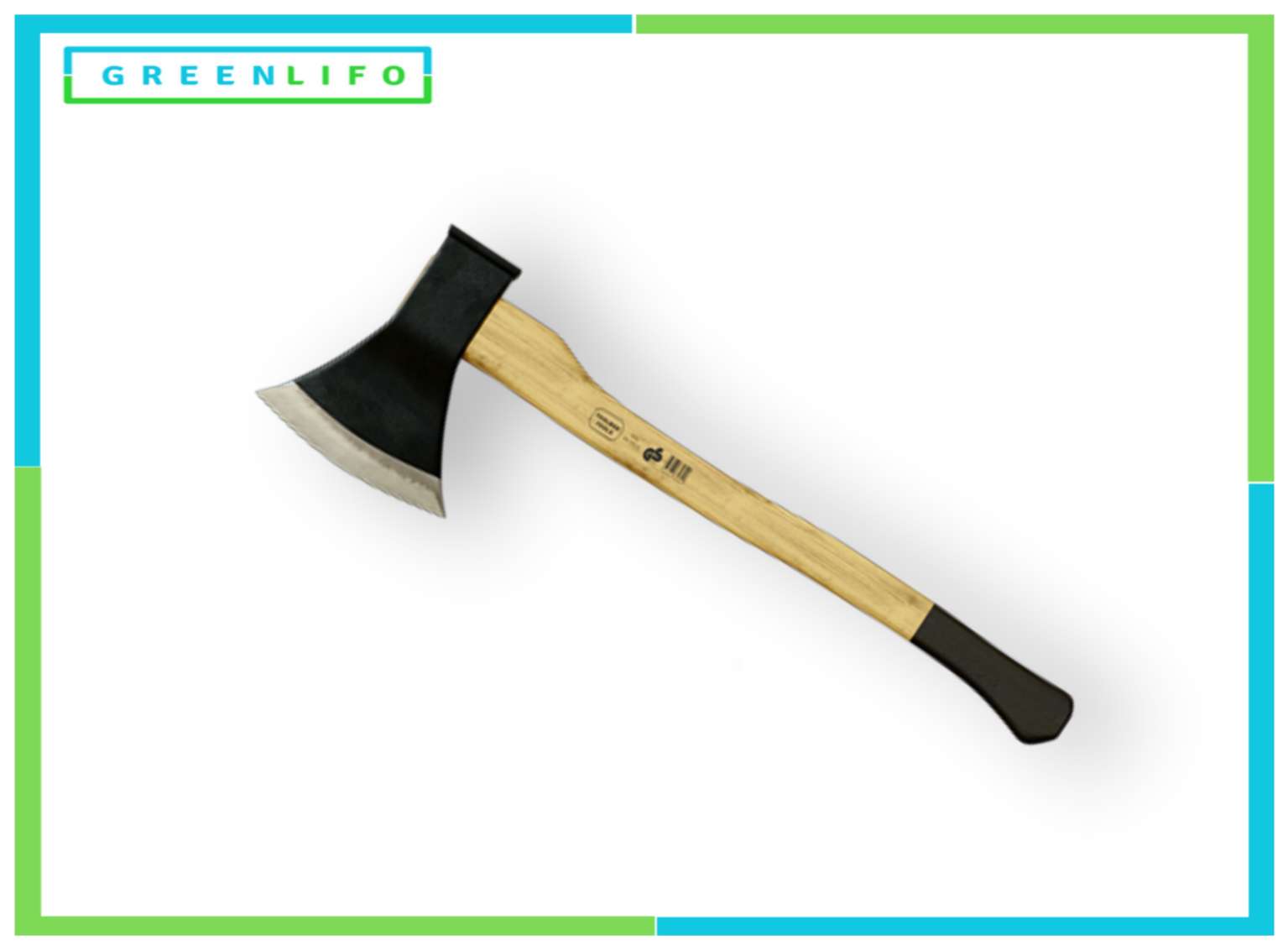
Axe tool is a cutting edge multi-purpose tool designed for a wide range of uses. It has a sharpened steel blade that is perfect for chopping and slicing food items as well as light to moderate pruning. Its sturdy handle provides an ergonomic grip, giving the user maximum control during use.
Here are the uses of a Axes:
1. Wood Splitting: Axes are primarily used for splitting wood, making them essential for preparing firewood and maintaining a heat source in cold climates.
2. Tree Felling: In forestry and logging, axes are used for cutting down trees. They are particularly helpful when dealing with smaller trees or for limbing larger ones.
3. Chopping: Axes are employed for chopping wood, such as logs or branches, into smaller, manageable pieces for various applications, including construction and campfires.
4. Construction: Carpenters and builders use axes to shape, trim, and cut timber for construction projects.
5. Clearing Vegetation: Axes can be used for clearing overgrown areas or removing unwanted vegetation, including bushes and roots.
6. Emergency and Survival: In survival situations, an axe is a valuable tool for shelter construction, making tools, and even self-defense.
7. Bushcraft: Bushcraft enthusiasts use axes for a wide range of outdoor activities, from crafting tools and utensils to building shelter and processing game.
14. Hand Trowel
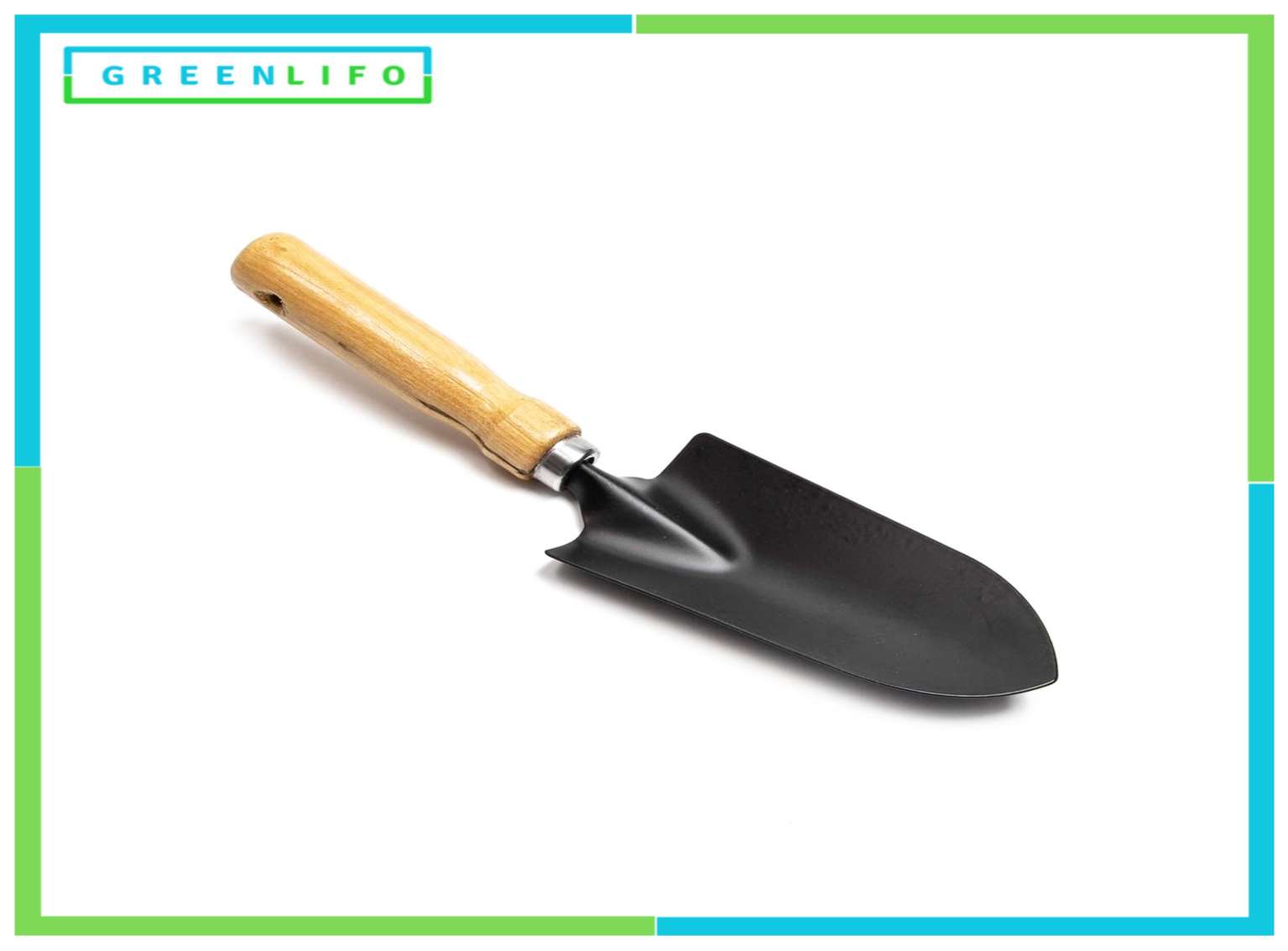
A hand trowel is a gardening tool that has a handle and a blade with a rounded end. It is used for digging, scooping, cultivating, weeding and other various farming and gardening tasks. Hand trowels are small and easy to maneuver, making them great for precision work.
Here are the uses of a Hand trowel:
1. Planting Bulbs: Hand trowels are ideal for digging small holes for planting flower bulbs, ensuring proper depth and spacing.
2. Transplanting Seedlings: Gardeners use hand trowels to carefully dig out and transplant young seedlings from one location to another.
3. Weeding: Trowels can be used to dig out weeds and their roots from the soil, helping to prevent weed overgrowth.
4. Loosening Soil: They are handy for breaking up compacted soil, ensuring better aeration and water absorption.
5. Digging Small Holes: Hand trowels are great for digging small holes to accommodate plants, herbs, or vegetables when creating a new garden bed or planting in containers.
6. Mixing Soil and Fertilizer: Gardeners use trowels to blend soil and fertilizer or soil amendments when preparing planting holes.
7. Harvesting Root Vegetables: Trowels are useful for digging up root vegetables like carrots and potatoes without damaging them.
8. Creating Furrows and Rows: When planting seeds in rows, hand trowels can create furrows to the desired depth for sowing.
9. Leveling Soil: Trowels are used to even out soil surfaces in garden beds and containers before planting.
10. Dividing Perennials: Gardeners can use a hand trowel to divide clumps of perennial plants during the process of propagation and rejuvenation.
15. Hand cultivator
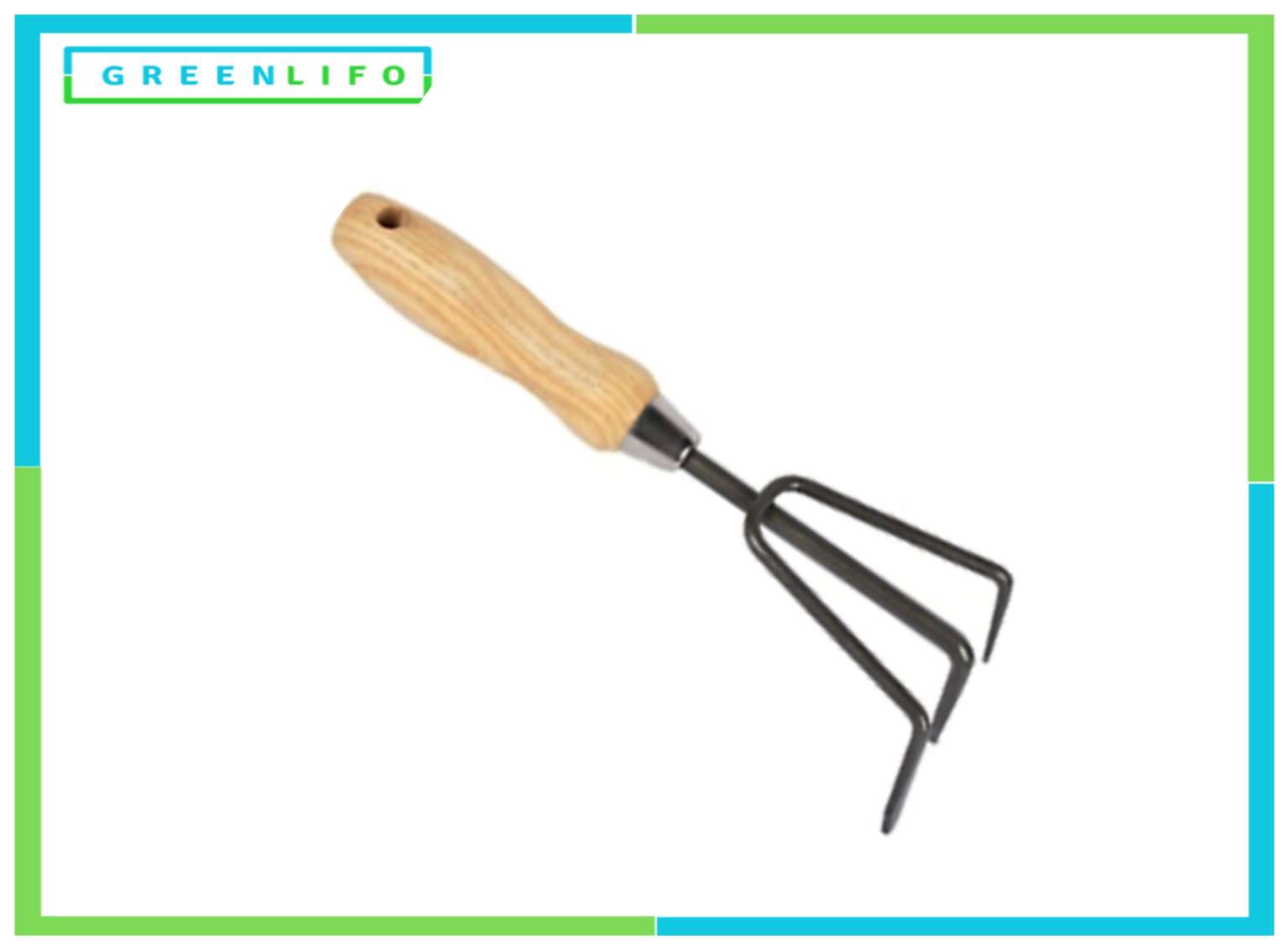
A hand cultivator is a farming and gardening tool used to aerate and prepare the soil in small areas of land. It consists of metal tines connected to a wooden handle, and it is designed for cultivating beds of vegetables, herbs, and flowers. This tool is also used for weeding and loosening the soil around existing plants or trees.
Here are the uses of a Hand cultivator:
1. Weeding: Hand cultivators are effective for loosening the soil around weeds, making it easier to remove them from the root.
2. Aerating Soil: They help in breaking up compacted soil, improving its structure, and promoting better air circulation and water absorption.
3. Mixing Soil and Amendments: Gardeners use hand cultivators to blend soil with organic matter or fertilizer when preparing a garden bed or planting hole.
4. Preparing Seedbeds: Hand cultivators are used to create a fine, crumbly seedbed for planting seeds by breaking up large clumps of soil.
5. Thinning Seedlings: When seedlings are overcrowded, a hand cultivator can be used to thin them by gently disturbing the soil and selectively removing excess plants.
6. Working Close to Plants: The small size of a hand cultivator makes it ideal for working around established plants in tight spaces, like between rows of vegetables.
7. Mixing Compost and Mulch: Gardeners use cultivators to incorporate compost or mulch into the soil, enriching it with organic matter.
8. Edging Garden Beds: They are useful for creating clean edges around garden beds, separating them from lawns or walkways.
9. Removing Surface Weeds: Hand cultivators can quickly remove small surface weeds without disturbing the surrounding plants.
10. Loosening Soil in Containers: When repotting or refreshing potted plants, hand cultivators help in loosening and aerating the potting mix.
16. Pickaxe
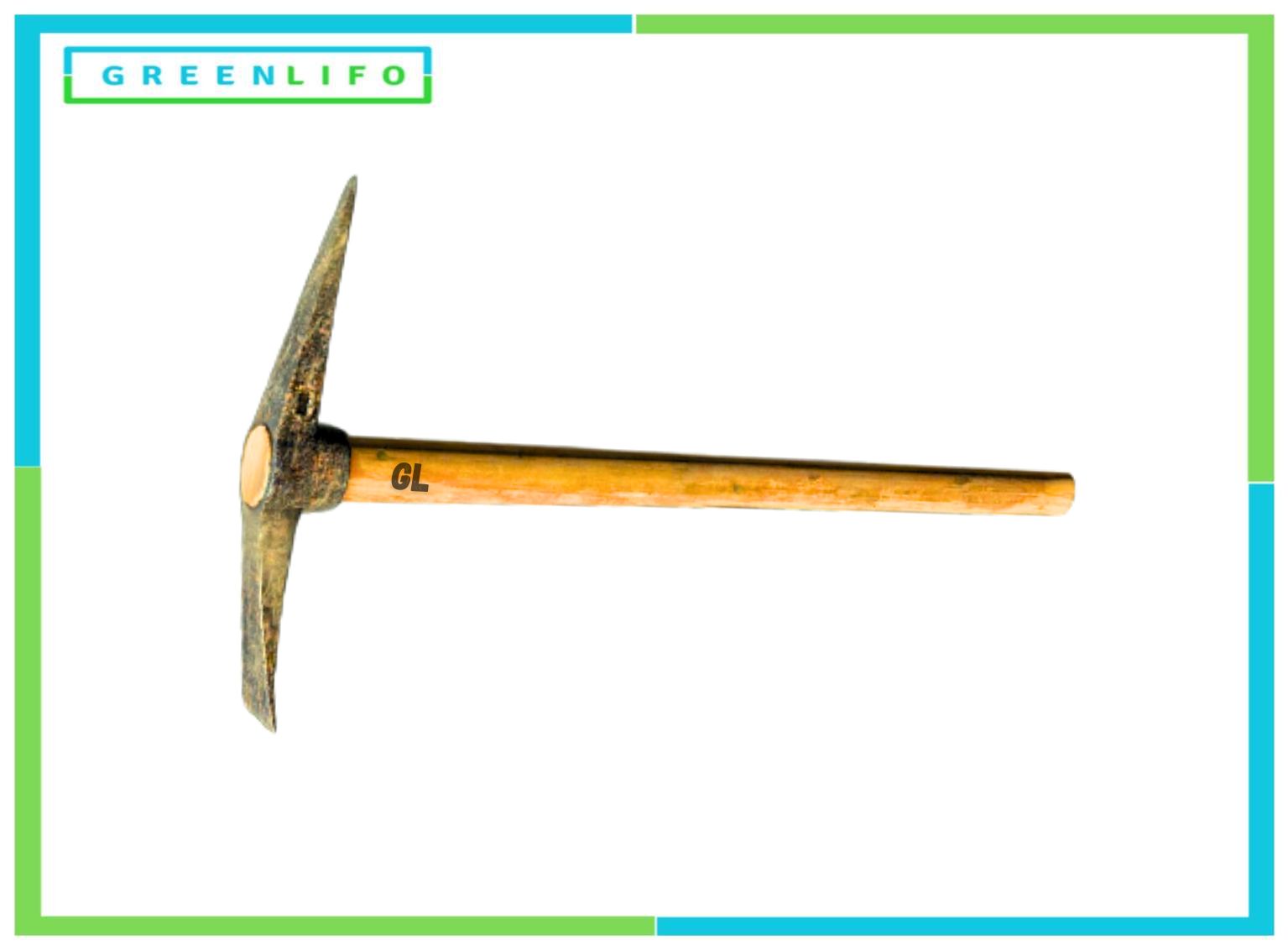
A pickaxe is a hand tool with a hard head attached to a handle, typically made of metal. It is most commonly used for breaking up rocks and soil, digging out trenches or holes, and sometimes as an ice axe for mountaineering.
Here are the uses of a Pickaxes:
1. Excavation: Pickaxes are widely used in construction and mining to dig and break through various materials, including soil, rock, and concrete.
2. Mining: In mining operations, pickaxes are used to extract minerals and ores by breaking up rock and ore deposits.
3. Demolition: Pickaxes can be employed in demolition work to break down walls, concrete structures, and other materials.
4. Trenching: For digging narrow trenches, such as those required for laying pipes or cables, pickaxes are essential tools.
5. Hard Soil Removal: When dealing with hard or compacted soil, pickaxes can loosen and break it up for gardening and landscaping.
6. Clearing Rocks and Debris: Gardeners and landscapers use pickaxes to clear areas of rocks, tree roots, and other obstructions.
7. Digging Holes for Posts: When installing fence posts or signposts, pickaxes are used to dig deep, narrow holes in the ground.
8. Ice and Frost Removal: In regions with freezing conditions, pickaxes can help break up ice and remove frost from surfaces like driveways and walkways.
17. Knife
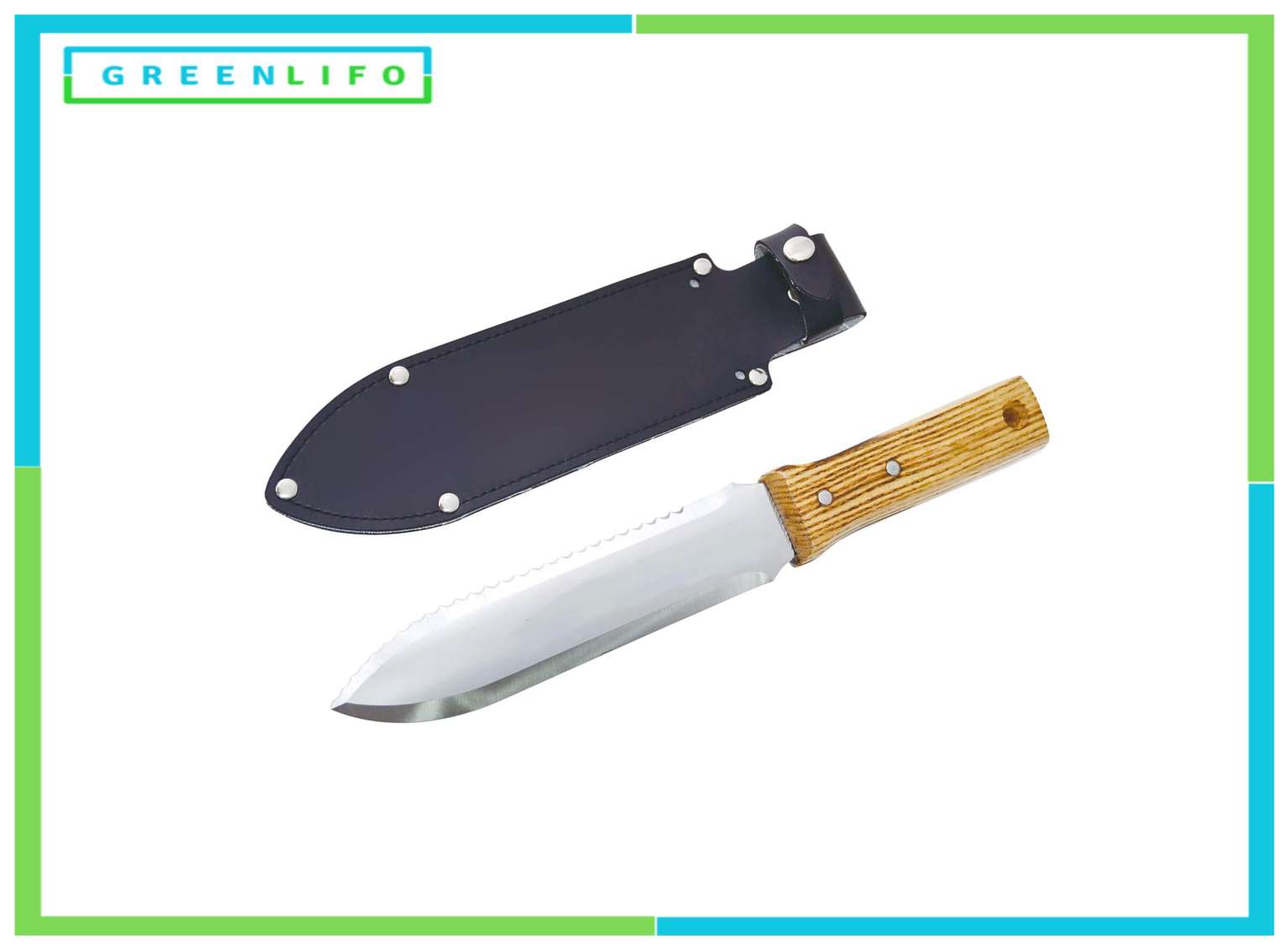
A knife is a versatile tool with many uses, ranging from culinary tasks such as cutting and chopping to craft projects like whittling. It can also be used in survival scenarios for things such as constructing shelter or hunting food.
Here are five common uses of a knife:
1. Food Preparation: Knives are widely used in the kitchen for cutting, chopping, slicing, and dicing food. They are essential for preparing ingredients for cooking and can range from small paring knives to larger chef’s knives.
2. Outdoor Activities: Knives are valuable tools for camping, hiking, and survival situations. They can be used for cutting rope, preparing firewood, and even for self-defense.
3. Everyday Tasks: In daily life, knives are handy for opening packages, cutting tape, and performing minor repair tasks. Pocket knives are particularly useful for such purposes.
4. Craftsmanship: Knives are used in various crafts, from woodworking and leatherworking to sculpture. They enable precision cutting and shaping of materials.
5. First Aid: In emergency situations, a knife can be used to cut clothing and bandages, remove splinters, and assist in basic first aid procedures.
These are just a few examples of the many uses of knives in different aspects of life. Knives come in a wide variety of types and sizes, each designed for specific tasks.
18. Sprinkler

A sprinkler is a handy farming and gardening device used to distribute water over an area of land in a controlled manner. This helps ensure an even distribution of water, which can improve the overall health and yield of plants, lawns, and gardens.
Here are five key uses of sprinklers:
1. Lawn Irrigation: Sprinklers are widely used to provide regular and even watering to lawns, ensuring that grass remains lush and healthy. They help prevent drought stress and promote consistent growth.
2. Garden Watering: In addition to lawns, sprinklers are useful for watering flower beds, vegetable gardens, and other plantings, delivering water directly to the soil around the plants.
3. Landscaping Maintenance: Sprinklers can be strategically placed to water trees, shrubs, and ornamental plants, helping to maintain the overall aesthetics of landscaping.
4. Time-Saving Convenience: Automated sprinkler systems can be programmed to water at specific times, reducing the need for manual watering and ensuring that your plants receive a consistent water supply.
5. Heat and Fire Protection: In regions prone to wildfires, sprinklers can be installed on rooftops and around properties to provide an emergency water source for fire suppression, helping protect homes and structures.
Sprinklers come in various types, including oscillating, stationary, and in-ground systems, each suited to different watering needs. They play a crucial role in maintaining healthy vegetation, conserving water, and protecting properties in various settings.
19. Tractor

A tractor is a powerful machine used on farms and in other agricultural settings to assist with a variety of tasks, such as tilling soil, plowing fields, hauling heavy materials and spraying fertilizers or pesticides.
Here are five common uses of tractors:
1. Farming: Tractors are fundamental in agriculture for tasks such as plowing, tilling, planting, and harvesting crops. They provide the power needed to pull various implements, making farming more efficient.
2. Landscaping and Grounds Maintenance: Tractors are used in landscaping to clear land, grade surfaces, mow large areas, and maintain sports fields and golf courses.
3. Construction: Tractors equipped with loaders or backhoes are used in construction for digging, moving heavy materials, and performing excavation work, making them crucial for building infrastructure.
4. Transportation: Tractors with trailers or semi-trailers are essential for transporting goods, particularly in the logistics and shipping industries, as they can carry heavy loads over long distances.
5. Forestry: In the forestry industry, specialized tractors are used for skidding, logging, and clearing land. They can move large logs and equipment in rugged terrain.
Tractors come in various sizes and configurations, each suited to specific tasks and industries, making them indispensable in agriculture, construction, and other sectors.
20. Cultivator

A cultivator is a type of farm equipment used for preparing soil and tilling the land. It has curved blades which rotate as it moves over the surface of the soil, loosening, aerating and breaking up the soil so that crops can be planted more easily.
Here are five common uses of a cultivator:
1. Seedbed Preparation: Cultivators are used to prepare the soil for planting by breaking up clumps, leveling the surface, and creating a fine, crumbly seedbed. This ensures that seeds or seedlings have a suitable environment for growth.
2. Weed Control: Cultivators are effective for weed control. By stirring the top layer of soil, they disrupt weed growth, making it easier to remove or prevent weeds from taking root and competing with crops or garden plants.
3. Aeration and Soil Mixing: Cultivators help in aerating the soil and mixing organic matter or fertilizer evenly, promoting better drainage and nutrient distribution in the soil. This is particularly important for improving soil structure and fertility.
4. Crop Residue Management: In agriculture, cultivators are used to break down crop residues after harvest, making it easier to incorporate them into the soil or prepare the field for the next planting season.
5. Tillage and Ground Preparation: For larger-scale farming, cultivators are employed in primary and secondary tillage operations. They can be used to turn over the soil, break compacted layers, and prepare fields for planting crops like corn, soybeans, and cotton.
Cultivators come in various sizes and configurations, from small hand-held models for gardening to larger tractor-mounted versions for extensive agricultural use. The specific type of cultivator used depends on the scale and purpose of the task at hand.
21. Harrow
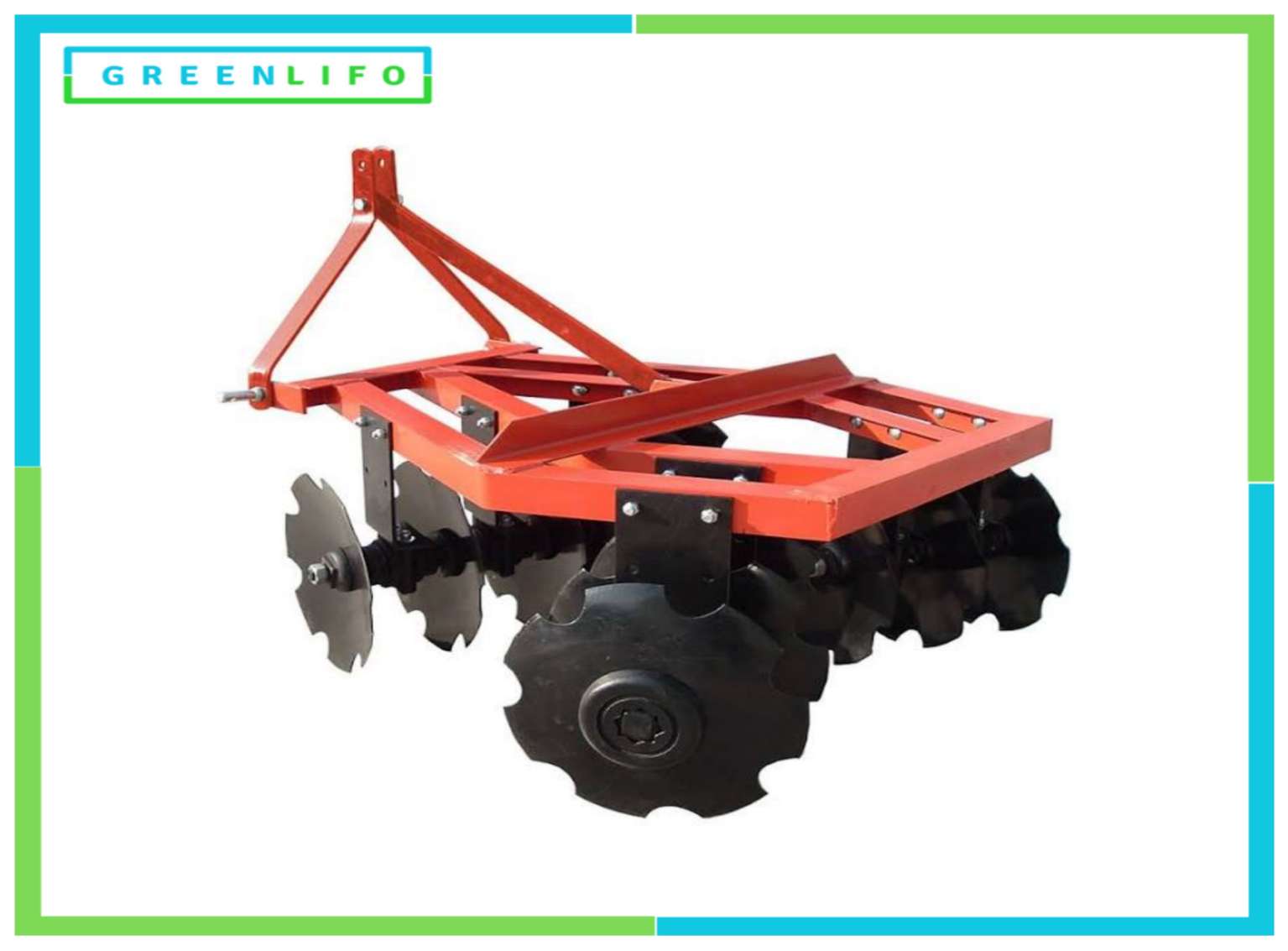
The Harrow is a versatile agricultural implement used for tilling, harrowing and breaking up soil. It has a wide variety of uses, such as turning over soil after plowing to create an even seedbed or incorporating manure into the topsoil.
Here are five common uses of a harrow:
1. Seedbed Preparation: Harrows are used to prepare the soil for planting by breaking up clumps, leveling the surface, and creating a fine, crumbly seedbed. This helps ensure optimal seed-to-soil contact and promotes uniform germination.
2. Weed Control: Harrows can be used to control weeds by disturbing the top layer of soil, which disrupts weed growth and buries weed seeds, preventing them from germinating.
3. Incorporating Crop Residues: After a crop is harvested, harrows can be used to incorporate crop residues, such as stalks and stubble, into the soil. This aids in decomposition and nutrient recycling.
4. Aeration and Soil Improvement: Harrowing can help aerate the soil by breaking up compacted layers and enhancing soil structure. It can also mix in organic matter or fertilizer, promoting better nutrient distribution and drainage.
5. Leveling and Smoothing Fields: Harrows are valuable for leveling and smoothing fields, particularly after plowing or other primary tillage operations. This ensures an even surface for planting and reduces potential hazards for farm equipment.
Harrowing implements come in various types, including disc harrows, tine harrows, and chain harrows, each suited to different tasks and soil conditions. The choice of harrow depends on the specific requirements of the farming or land preparation operation.
22. Plough
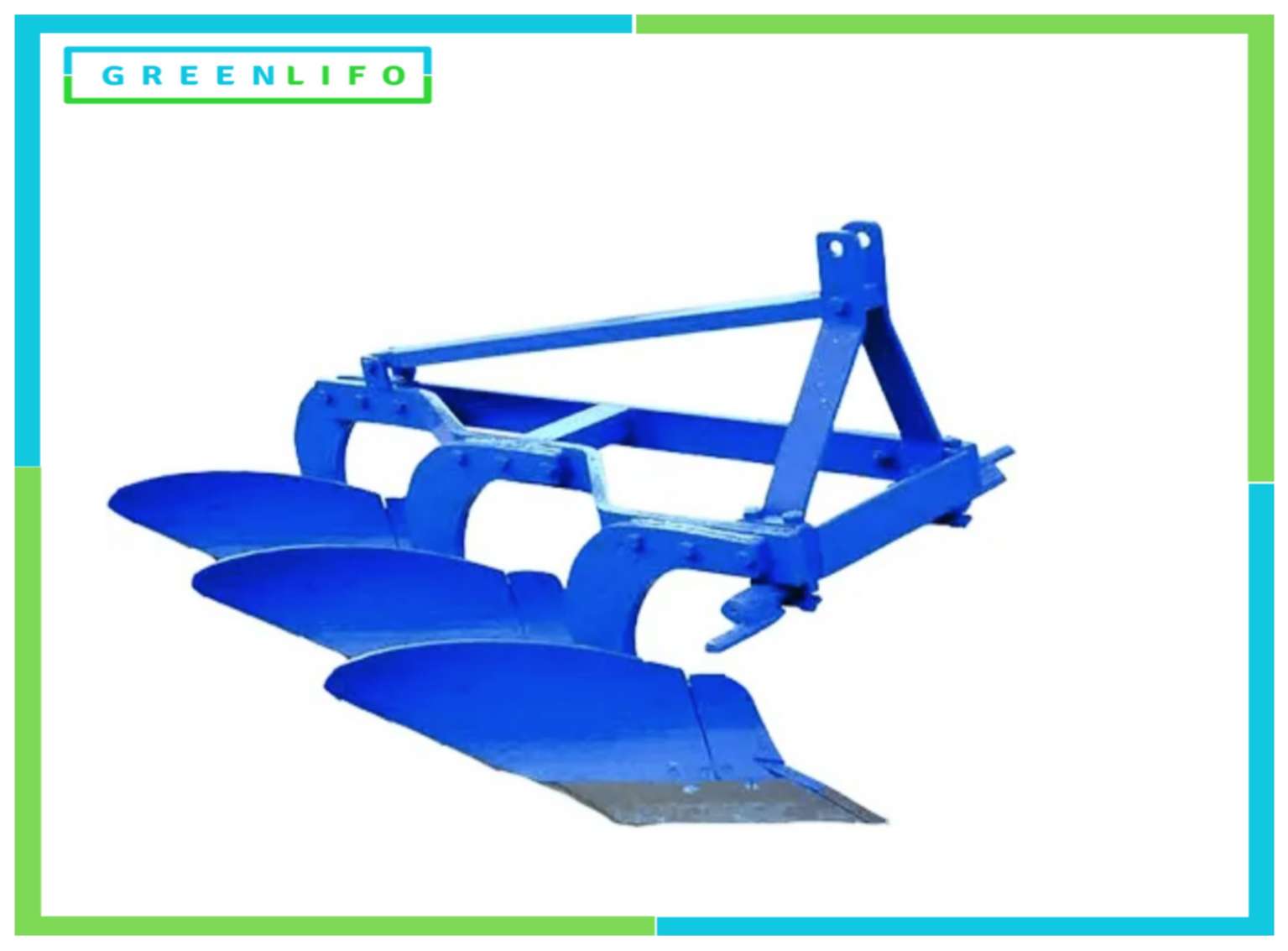
A plough is an ancient agricultural implement which has been used for centuries. It serves the purpose of cultivating soil to prepare it for planting, making it one of the most important pieces of farm equipment.
Here are five common uses of a plough:
1. Turning and Breaking Soil: The primary purpose of a plough is to turn over and break up the soil, particularly in the initial stages of preparing a field for planting. This helps bury crop residues, incorporate organic matter, and expose fresh soil for improved aeration and drainage.
2. Seedbed Preparation: Ploughs play a key role in preparing a suitable seedbed by breaking clumps, leveling the soil, and creating a fine, crumbly texture. This ensures that seeds or seedlings have an ideal environment for germination and root development.
3. Weed Control: Ploughing can help control weeds by burying weed seeds and disrupting weed growth in the upper soil layer. This is especially important for minimizing weed competition with crops.
4. Crop Rotation: Ploughs are used to prepare fields for crop rotation, where different crops are planted in successive seasons to manage soil fertility and reduce the risk of pests and diseases associated with monoculture.
5. Incorporating Fertilizer: Ploughs can be used to incorporate fertilizers or soil amendments into the soil, ensuring an even distribution of nutrients for the growing crops.
Ploughs come in various types, including moldboard ploughs, disc ploughs, and chisel ploughs, each designed for specific purposes and soil conditions. The choice of plough depends on the farmer’s specific needs and the nature of the soil and crops being cultivated.
23. Subsoiler
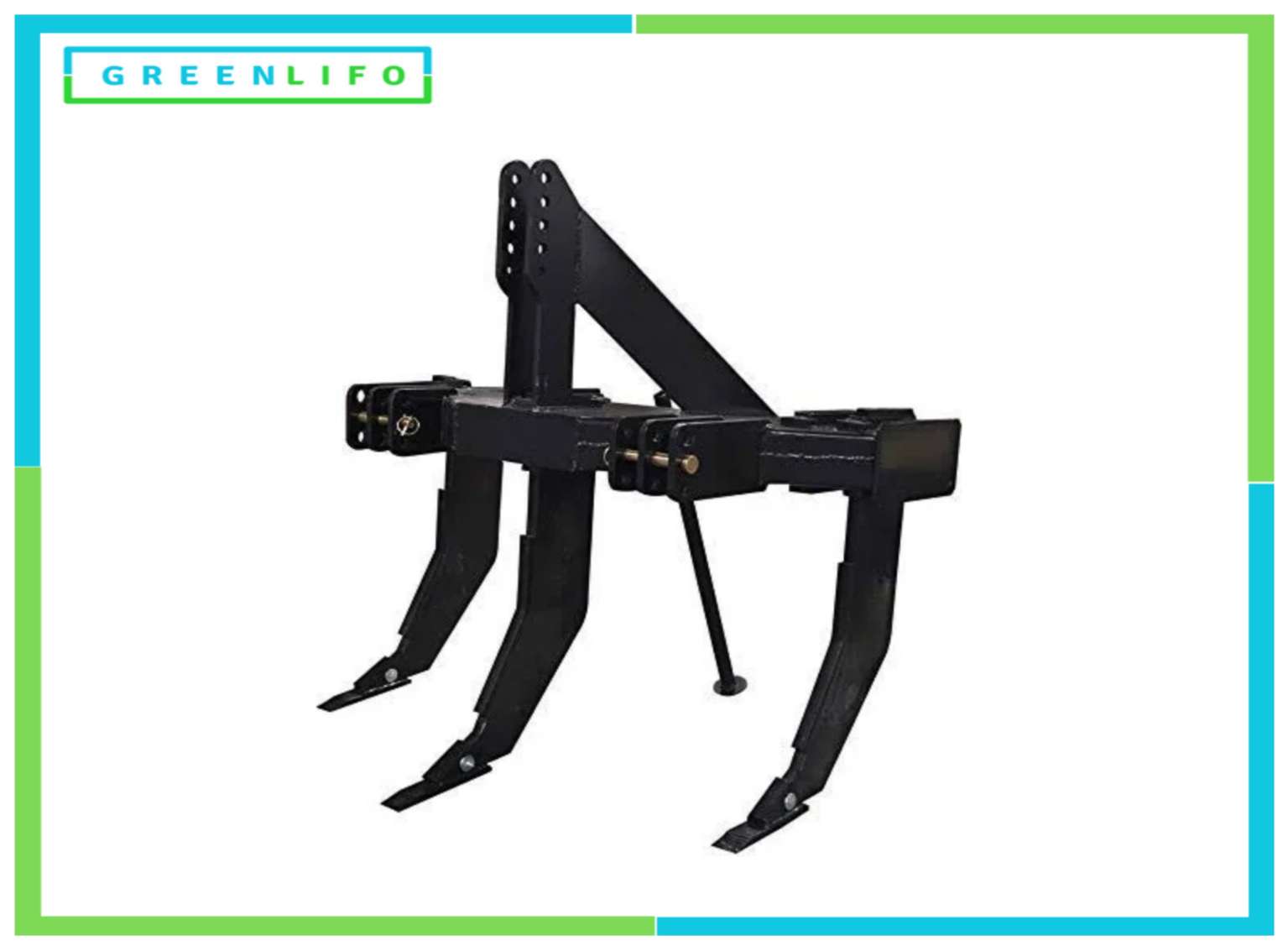
A subsoiler is an agricultural tool used to break up and loosen soil layers. It is typically made of metal blades attached to a metal frame, and it penetrates deeply into the soil when pulled by a tractor or other large machinery.
Here are five common uses of a subsoiler:
1. Soil Compaction Reduction: Subsoilers are used to break up compacted layers of soil that can hinder root growth and water infiltration. By fracturing the compacted soil, they improve soil structure and reduce compaction, promoting healthier root systems.
2. Water Infiltration Improvement: Subsoilers create channels in the soil, allowing water to penetrate deeper into the ground. This enhances water retention and reduces the risk of surface runoff, making it beneficial for dryland farming and water conservation.
3. Aeration of Deep Soil: Deep tillage with a subsoiler enhances soil aeration at greater depths, facilitating the exchange of gases, root respiration, and microbial activity. This can lead to better nutrient availability and overall soil health.
4. Root Growth Enhancement: Subsoilers help plants access nutrients and moisture deeper in the soil, promoting more extensive root systems that are better equipped to withstand drought conditions.
5. Crop Yield Improvement: Proper subsoiling can lead to increased crop yields by addressing issues like soil compaction and limited root access to nutrients and moisture, ultimately creating more favorable growing conditions.
Subsoilers come in various designs, including shank-type and deep-tillage subsoilers, and are generally used in combination with other tillage equipment. The choice of subsoiler and depth of operation depend on the specific soil conditions and the desired improvements in soil structure and crop performance.
24. Seed Drill
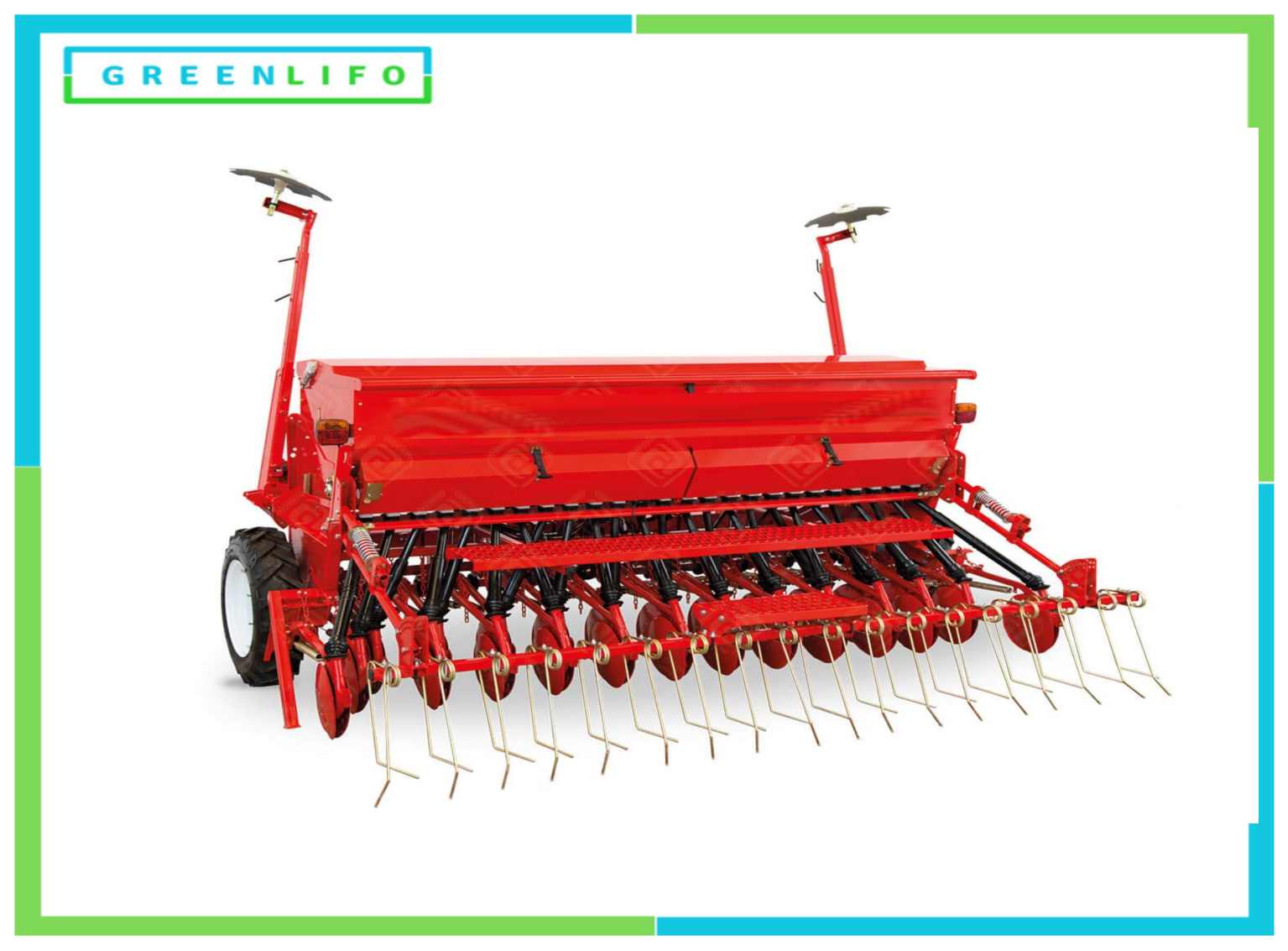
The seed drill is an agricultural implement used to plant seeds into the soil in neat rows.seed drill makes crop planting much easier and more efficient.
Here are five common uses of a seed drill:
1. Accurate Seed Placement: Seed drills ensure that seeds are planted at consistent depths and spacing, resulting in uniform crop emergence. This accuracy enhances crop establishment and reduces seed wastage.
2. Time and Labor Efficiency: Seed drills save time and labor compared to manual or broadcast seeding methods. They can cover a large area quickly and require fewer people for planting.
3. Conservation of Seeds: By precisely placing seeds at the desired depth and spacing, seed drills help conserve seeds, reducing the overall cost of planting and ensuring efficient resource utilization.
4. Optimal Row Spacing: Seed drills are designed to plant seeds in rows with uniform spacing. This facilitates weeding, irrigation, and crop maintenance as well as the use of farm machinery between rows.
5. Crop Yield Enhancement: The uniform seed placement achieved with seed drills leads to consistent plant populations and reduced competition between plants. This results in improved crop yields and better-quality produce.
Seed drills come in various configurations, including no-till and minimum-till options, and can be adjusted to accommodate different types of seeds and row spacing. Their use is particularly important in modern agriculture to achieve precise and efficient seeding, contributing to higher crop productivity and sustainability.
25. Harvester
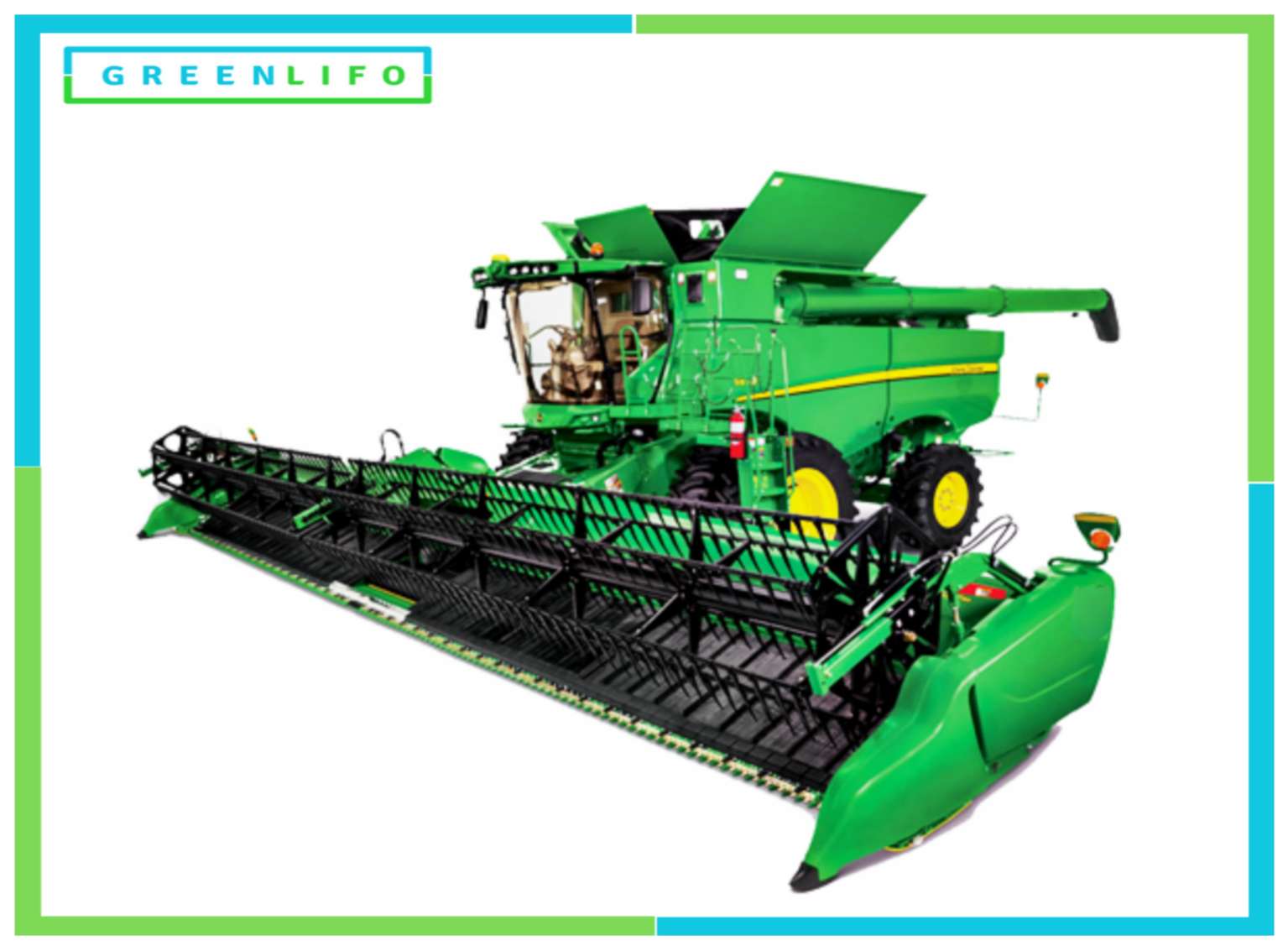
A Harvester is a machine that is used for harvesting crops. It is equipped with a variety of tools and technologies, including combine harvesters, swathers, balers and others, to make the job easier and more efficient.
Here are five common uses of a harvester:
1. Crop Harvesting: Harvesters are primarily used for the efficient and timely collection of crops such as wheat, rice, corn, soybeans, and more. They significantly reduce the manual labor required for large-scale harvesting.
2. Grain Separation: Harvesters have mechanisms for separating the harvested grains from the rest of the plant. This separation process ensures that only the valuable parts of the crop are collected.
3. Straw or Stover Collection: In addition to the edible portion of the crop, harvesters can also collect and bale the straw, stalks, or stover, which can be used for animal bedding, mulch, or as a source of biomass for various applications.
4. Efficiency and Speed: Harvesters are designed for speed and efficiency, enabling farmers to complete the harvest quickly and reduce crop losses due to weather or over-ripening.
5. Versatility: Harvesters are often equipped with attachments and settings that allow them to be used for different crops and conditions. They can be adapted for use in various types of agriculture, including conventional, no-till, and specialty crops.
Harvesters are crucial machines in modern agriculture, significantly improving the efficiency of the harvest process, reducing labor costs, and ensuring that crops are collected at their peak quality and maturity.
Conclusion
We hope that this article has given you an insight into the importance of farm tools and equipment, as well as their uses in farming. With knowledge of the different farm equipment available, farmers can plan ahead and be prepared for any situation. A successful harvest season starts with having the right tools and equipment to ensure productivity and efficiency.
FAQs
What are the most commonly used tools in a farm?
Commonly used tools in a farm include tractors, plows, cultivators, hoes, rakes, shovels, sickles, pruning shears, and hedge trimmers. Depending on the type of farming being done other tools may also be necessary.
What are the types of farming equipment?
Farming equipment comes in a variety of forms, ranging from manual tools and machines to large mechanized pieces. Manual tools used for farming include shovels, hoes, rakes, and spades. Machines used in farming can range from small tractors to combines and plows. Large mechanized farming equipment includes seed drills, grain augers, feed mixers, and more.
What are farmers tools?
Farmers tools are items that are used by farmers to perform tasks on the farm. These can include tools such as tractors, ploughs, rakes, shovels, wheelbarrows and other types of farming machinery. They may also use tools such as axes, hoes, shears and pruning saws for more specific tasks related to crop or animal care.
What is the most important common farm equipment or tool?
The most important common farm equipment or tool used on farms is a tractor. Tractors are used for a variety of tasks, such as plowing, planting, cultivating, harvesting and transporting crops and materials around the farm. They are an invaluable piece of machinery that helps farmers get their work done more quickly and efficiently.
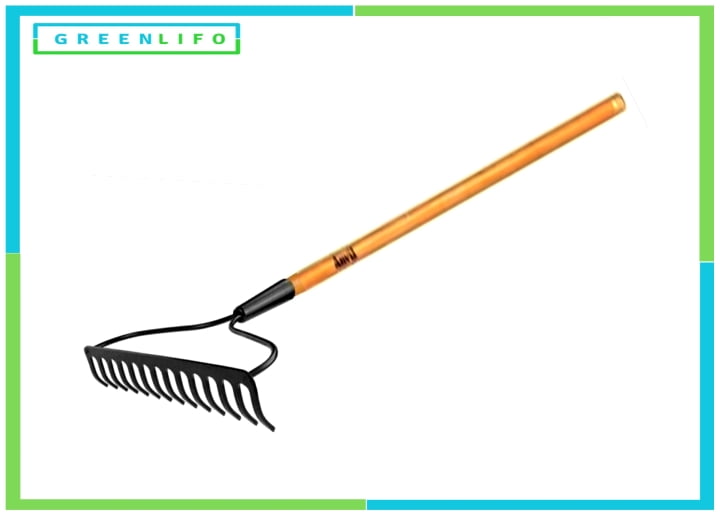
2 thoughts on “Common farm tools and equipment: Names, pictures, and uses”